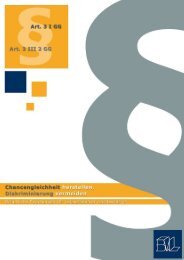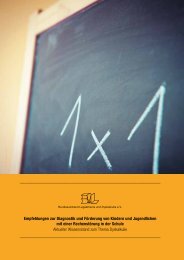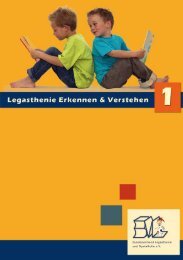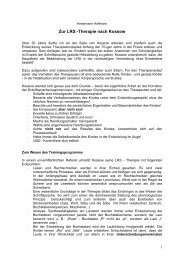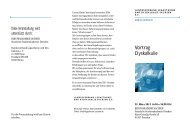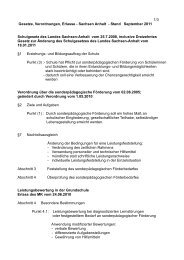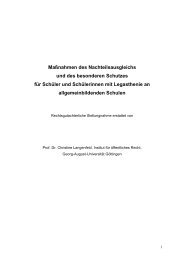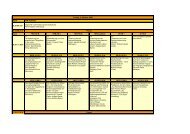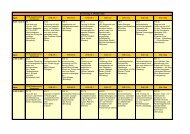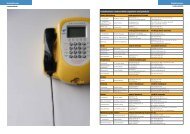Testverfah - Bundesverband Legasthenie und Dyskalkulie eV
Testverfah - Bundesverband Legasthenie und Dyskalkulie eV
Testverfah - Bundesverband Legasthenie und Dyskalkulie eV
Sie wollen auch ein ePaper? Erhöhen Sie die Reichweite Ihrer Titel.
YUMPU macht aus Druck-PDFs automatisch weboptimierte ePaper, die Google liebt.
Abstractband 15. Kongress des <strong>B<strong>und</strong>esverband</strong>es <strong>Legasthenie</strong><br />
mit Traurigsein, Selbstmordgedanken, Schlaf- <strong>und</strong> Essstörungen herum (Esser <strong>und</strong><br />
Schmidt 1993). Psychotherapie kann nur die psychiatrische Zusatzsymptomatik<br />
positiv beeinflussen, bereitet aber zum Teil erst das Feld für eine erfolgreiche spezifische<br />
Übungsbehandlung.<br />
Literatur: Esser u. Schmidt, Zeitschrift für Klinische Psychologie 22, 1993; Esser,<br />
Wyschkon u. Schmidt, Zeitschrift für Klinische Psychologie 31, 2002<br />
Korrespondenzautor: Ulrike Lehmkuhl<br />
ulrike.lehmkuhl@charite.de<br />
++49 030 450566201<br />
++49 030 450566921<br />
Brain responses as early predictors of reading problems and indices of persistent<br />
processing differences<br />
*Paavo H. T. Leppänen (1), Tomi K. Guttorm (2), Jarmo Hämäläinen (2), Minna<br />
Torppa (2), Anne Puolakanaho (2), Anna-Maija Poikkeus (2), Kenneth M. Ekl<strong>und</strong> (2),<br />
Paula Lyytinen (2), Heikki Lyytinen (2)<br />
(1) Jyväskylä Longitudinal Study of Dyslexia, University of Jyväskylä, Jyväskylä, Finland; (2)<br />
We examined the association of infant brain responses with reading and writing<br />
skills in children with risk for familial dyslexia and brain activation differences in<br />
those who became poor readers at school age. We had earlier fo<strong>und</strong> differences between<br />
6-month-old infants with and without risk for familial dyslexia in event-related<br />
brain potentials (ERPs) for consonant duration change in two-syllable pseudowords<br />
(/ata/ vs. /atta/) presented in a mismatch negativity (MMN) -paradigm. The sixmonth-ERPs<br />
were also fo<strong>und</strong> to predict later language and phonological skills. We<br />
present here findings of associations of the infant brain responses with 1st and 2nd<br />
grade reading skills and brain activation differences at pre-school and school age.<br />
The correlations between 6-month-ERPs and later reading and writing skills were<br />
more consistent among at-risk children. Both response amplitude and latency measures,<br />
fo<strong>und</strong> for both the standard and deviant stimuli, were associated with reading<br />
and writing skills. Poor readers also differed from good readers in 6-month-ERP<br />
measures. The ERPs measured in the similar MMN-paradigms for the same /ata/<br />
and /atta/ pseudowords at pre-school age (6.5 years) and at the 3rd grade (9 years)<br />
also revealed differences between at-risk and control children as well as between<br />
poor and good readers, respectively. The high-dense array recordings at the 3rd<br />
grade showed differences in both the scalp current density maps as well as in the<br />
waveform of the ERPs.<br />
Our findings suggest persisting developmental differences in the organization of the<br />
neural networks sub-serving speech perception with cascading effects on later reading<br />
skills in children with familial backgro<strong>und</strong> for dyslexia.<br />
Korrespondenzautor: Paavo Leppänen<br />
Paavo.Leppanen@psyka.jyu.fi<br />
++358 14 2602882<br />
++358 14 2604400<br />
52



